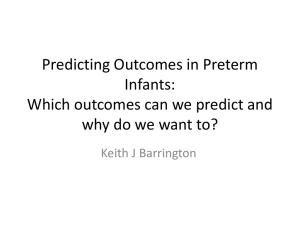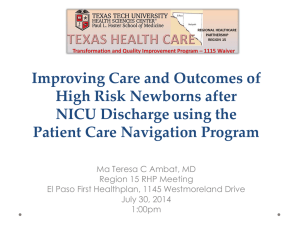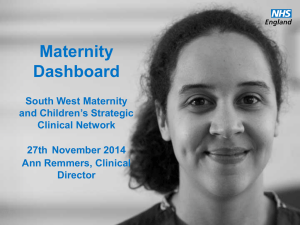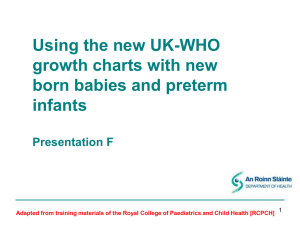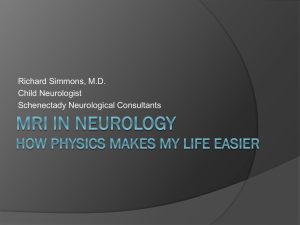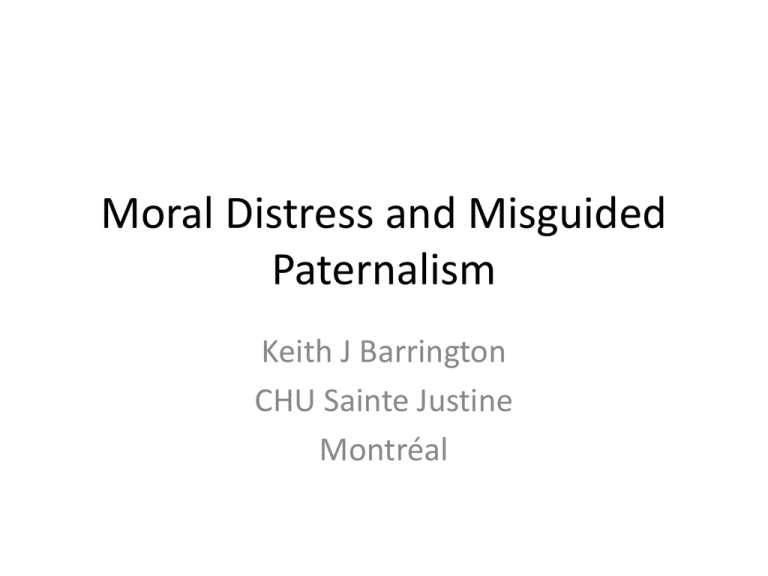
Moral Distress and Misguided
Paternalism
Keith J Barrington
CHU Sainte Justine
Montréal
• I have no conflicts of Interest to disclose
Moral Distress
• It is not rare in the NICU to feel ethically
conflicted
• Dealing with high risk patients who need
intensive care support ‘naturally’ leads to
situations where opinions differ
• Differing opinions lead to conflict about
treatment options
Moral Distress in the NICU
• Janvier A, Nadeau S, Deschenes M, Couture E,
Barrington KJ: Moral distress in the neonatal
intensive care unit: caregiver's experience. J
Perinatol 2007, 27(4):203-208.
• Questioned nurses and pediatric residents
Results
• 279 questionnaires
• Nurses in MUHC: Children's Hospital NICU,
obstetrics and NICU at Royal Victoria Hospital:
– 78-90% participation full time nurses: total
= 115 nurses
• Residents in pediatrics and obstetrics at all
Quebec Universities: McGill (Montreal),
Montréal, Laval (Québec), Sherbrooke
– 90-100% participation: 164 residents
Ethical confrontation vs estimations of outcome of infants
born at 25 weeks GA and willingness to intervene
>often
Nurses Outborn
Nurses Inborn
Nurses OB
Ped A
Ped B
Ped C
Ped D
Obs A
Obs B
Obs C
Obs D
56
24
22
28
22
0
36
6
6
0
25
>25% CP CP 40% alw brad 25
69
39
18
37
8
70
54
6
65
48
4
36
53
22
56
69
38
23
41
12
71
50
6
28
61
28
28
64
7
29
31
0
69
Why do caregivers experience moral
distress in the NICU?
• Our data showed that many residents and nurses
frequently (19% and 35%) experienced ethical
confrontation
• Strong association between overestimate of
disability among former extremely preterm
infants and moral distress.
• Nurses who experienced a lot of moral distress
were more likely to overestimate the proportion
of extremely preterm babies who were
‘handicapped’
Caregivers and moral distress
• We also showed big differences in the
frequency of moral distress between residents
working in different universities
• Also between nurses working in a children’s
hospital NICU and those working in a
maternity hospital NICU
• Residents who worked in a center where 23
week babies were never resuscitated thought
that a very high proportion of them would
develop CP.
• They were rarely morally distressed, they
thought that what they were doing was just
fine.
• Nurses working in a children’s hospital NICU
thought that most very premature babies were
impaired. They were frequently morally
distressed.
– The extremely preterm babies that they see do indeed
have more CP
• Nurses in the maternity hospital NICU also overestimated the prevalence of CP, but much less,
and they were much less frequently distressed.
Misapprehension
• Many respondents had very erroneous
estimates of impairment among very preterm
babies
• If they then had to take care of them anyway,
they were distressed.
• Those with the most erroneous estimates of
impairment were much less likely to want to
resuscitate a very preterm baby.
What kinds of Conflicts do we
Encounter?
• Most ethical conflicts in the NICU (in several
different countries) occur over end of life care.
• Usually; parents desire is to continue active care
and the care team, or some members of it, think
that comfort care would be more appropriate
(80% of EoL conflicts)
– Some activists seem to think it is the converse, that
we are commonly coercing parents into NICU care
• Many of these differences of opinion turn around
neurological prognosis
Neurologic Prognosis in the NICU
Neonatologists love numbers
23 weeks
intervention,
25% survival
Comfort care:
Baby dies
BUT, she might still die
In the NICU (75% do)
IF she survives
40% have a
minor disability:
-Hyperactivity
1 / 4 have major disability -Dyslexia
-Behavior
-CP (8-10%)
- Learning
-deafness (3%)
difficulty
-blindness (2%)
-developmental delay
- Bla bla bla
1 in 2 are
OK
Trying to Predict Handicap
• 'An impairment is any loss or abnormality of psychological,
physiological or anatomical structure or function;
• a disability is any restriction or lack (resulting from an
impairment) of ability to perform an activity in the manner
or within the range considered normal for a human being;
• a handicap is a disadvantage for a given individual, resulting
from an impairment or a disability, that prevents the
fulfilment of a role that is considered normal (depending on
age, sex and social and cultural factors) for that individual'.
– WHO 1976
Predicting Disability
• Which disabilities do you want to talk about?
• A low Bayley score is not a disability!
• A low Bayley score is an indication of delayed
development,
• Many infants with low Bayley scores will not
have ‘Cognitive Impairment’
• Very few infants with low Bayley scores will be
so badly impaired that there is substantial
effect on their QoL
Does a low Bayley MDI mean that an infant
has cognitive impairment? Hack et al
Neurosensory Status at 20 Months
Total Population (n = 200):
8-Year MPC
Normal (n = 154): 8-Year
MPC
20month
MDI
<70
70–84
85
Total
<70
29
21
28
78
(39%)
9
70–
2
15
39
56
(28%)
85
1
6
59
66
(33%)
32
42
126
84
Total
(16%) (21%) (63%)
<70 70–84
Abnormal (n = 46): 8-Year
MP
85
Total
<70
70–84
85
Total
16
20
45
(29%)
20
5
8
33
(72%)
1
12
36
49
(32%)
1
3
3
7
(15%)
0
5
55
60
(39%)
1
1
4
6
(13%)
10
33
111
22
9
15
(7%) (21%) (72%)
(48%) (20%) (32%)
Colombo and Carlson
Pediatrics: June 2012
• The BSID is a global test designed to identify developmental delay.
Its role and place within the field of developmental science
is relatively well established. The BSID is, to be charitable, only
modestly related to school-age cognitive development (ie, the
outcome that is most meaningful to investigators in this field). The
BSID is a global measure of developmental status in infancy that
assesses and aggregates the timely attainment of relatively crude
milestones in infancy and early childhood.
• Simply, the BSID is not an adequate indicant of specific cognitive
skills that may be differentially affected by interventions or
exposures, nutritional or otherwise, and so its use to evaluate the
construct of infant cognition is seriously deficient in the context of
recent advances in developmental science.
Reasons for trying to predict disability
•
•
•
•
•
To focus follow up programs
To initiate targeted early intervention
To prepare parents for their future
To understand the causes of disability
To perform research to reduce disability, or the
impacts of disability
• To redirect intensive care to comfort care, and
eliminate disabled children
Head Ultrasounds
• What is their sensitivity and specificity for
predicting outcomes?
• Systematic Review of findings on ultrasound
and long term
• Outcomes of babies with normal ultrasounds
What about the 3 day ultrasound?
• If we focus specifically on the ultrasound done
at 72 hours…
• What is the PPV of ANYTHING that you can
see on the ultrasound at 72 hours.
Kuban et al ELGAN study 2007
Table 2 The percentage of all scans read by pairs of readers that were read concordantly
(positive/positive, negative/negative) and discordantly (positive/negative, negative/positive)
First reader
Second
reader
Intraventricular
hemorrhage
Positive
Positive Negative Positive
19
6
9
Negative
5
Positive Negative Positive Negative
11
11
5
3
Negative
6
Agreement
76
(%)
Kappa
Ventriculomegaly
(moderate/severe)
Hyperechoic
lesion
Hypoechoic
lesion
69
4
83
13
65
3
89
92
69
94
46
86
63
97
0.68
N=1450
0.63
0.32
0.62
Results of review
Authors
year
Whitaker
Pinto-Martin
Aziz
EpiPage
Vollmer
Ment
Broitman
1996
1995
1995
2006
2005
Outcome
Age
IQ < -2SD
6y
Disabling CP
2y
CP and/or DQ<-2SD
1y
Disabling CP
2y
Disabling CP
8y
de Vries
Mirmiran
Pierrat
1999 IQ < -2SD
2007 DQ < -2SD
Disabling CP
DQ < -2SD
Disabling CP
2004 CP
2004 CP
2001 CP
McMenamin
1984 CP and/or DQ<-2SD
2y
4.5y
18-22mo
18-22mo
18-22mo
18-22mo
2y
31mo
36mo
Ultrasound Grade
PPV
n with this lesion
Parenchymal Lesion or VE
42%
46
Parenchymal Lesion or VE
52%
63
IVH + IPE + VE
79%
14
Parenchymal Lesion
65%
85
Parenchymal lesion on L
16%
17
Parecnhymal lesion on R
8%
16
Bilateral parenchymal
31%
106
Ventriculomegaly Mod/severe
56%
11
"Grade 4"
52%
145
"Grade 4"
42%
145
Cystic PVL
60%
50
Cystic PVL
50%
50
Cystic PVL
50%
49
Parenchymal abN or VE
33%
14
Extensive cystic PVL
96%
28
Localized cystic PVL
74%
38
Large IPE
75%
8
Small IPE
30%
22
ELGAN study
•
•
•
•
•
Infants less than 28 weeks gestation (n= 1450)
Followed to 2 years
Of those with Normal Head ultrasound scans:
Bayley 2 MDI 23% <70
Bayley 2 PDI 26% <70
O’Shea TM et al, Pediatrics 2008
TABLE 7
Measures of the Ability of Head Ultrasound Abnormalities Evident Before Discharge From
the NICU to Predict an MDI or PDI >2 SDs Below the Expected Mean at 24 Months’
Corrected Age
Ultrasound
Lesion,
Bayley
Scale < 70
Predictive
value
positive
Predictive
value
negative
Sensitivity
Specificity
Ventriculomegaly
MDI
Echolucent Lesion
PDI
MDI
PDI
45
55
45
61
76
72
75
71
17
93
17
94
12
95
14
96
Grade and laterality of intraventricular haemorrhage to predict 18–22 month neurodevelopmental
outcomes in extremely low birthweight infants
Acta Paediatrica
Volume 101, Issue 4, pages 414-418, 16 JAN 2012 DOI: 10.1111/j.1651-2227.2011.02584.x
http://onlinelibrary.wiley.com/doi/10.1111/j.1651-2227.2011.02584.x/full#f3
Grade and laterality of intraventricular haemorrhage to predict 18–22 month neurodevelopmental
outcomes in extremely low birthweight infants
Acta Paediatrica
Volume 101, Issue 4, pages 414-418, 16 JAN 2012 DOI: 10.1111/j.1651-2227.2011.02584.x
http://onlinelibrary.wiley.com/doi/10.1111/j.1651-2227.2011.02584.x/full#f2
Is the MRI better?
• MRI at discharge
MRI
Woodward et
al, NEJM 2006
167 infants
<30 wk, MRI
at term and 2
yr exam.
Woodward et al
• What really matters to a parent: with this finding on MRI
what is the likelihood that my baby will be severely
impaired?
– I.E. what is the PPV
• Now that the MRI is normal what is likelihood that my
baby will be “normal”?
– What is the NPV
• PPV from Woodward et al of Moderate to Severe AbN on
MRI for severe impairment (incl. MDI or PDI < 70) 30%
• NPV 95%
Miller et al
• Moderate or severe White matter injury on preterm
MRI
– PPV = 29% for a DQ <70 or disabling CP at 2 y
• Moderate or severe White matter injury on MRI at
term
– PPV = 42% for a DQ <70 or disabling CP at 2 y
• In other words when we see moderate or severe
WMI on an MRI most of the babies will have a good
outcome!
Other MRI prediction studies
• Shah DK 2006,
– PPV 50%, NPV 97%
• Mirmiran M 2004
– PPV for CP 50%
• Valkamaran AM 2000
– PPV of parenchymal lesions for CP, 58%
• Arzoumanian
2003
– PPV 10%
• Leijser LM 2008
– PPV 43% for severe abN outcome
MRI near term for predicting outcome
• An important research tool, which might help
us to understand the long term difficulties of
preterm infants
• This is not the same as saying that everyone
should have one!
• It has become a default in many NICUs
• The medical community has decided that this
is now standard of care
Neonatalresearch.org
• The outcome articles are often trying to
predict?
• 18 to 24 month Bayley MDI less than 70.
• We have often counselled parents for
withdrawal of life sustaining interventions
because of an increased risk of that outcome
• Is this misguided paternalism?
Clinical Course
• Clinical Features are more predictive of long
term outcome than any finding on head
ultrasound or MRI
– NEC, Postnatal Dexamethasone, Sepsis, poor
nutrition, surgery (any)
– Surgical NEC and sepsis increases CP prevalence
by more than 4 fold
Socio-economic status of parents
• The most important factor predicting long
term outcomes
Criteria for a Screening Test
•
•
•
•
Highly Sensitive
Very Specific
Identify treatable conditions
http://www.screening.nhs.uk/criteria
– 6. The distribution of test values in the target population should be known and a suitable cutoff level defined and agreed.
– 8. There should be an agreed policy on the further diagnostic investigation of individuals with
a positive test result and on the choices available to those individuals
– 10. There should be an effective treatment or intervention for patients identified through
early detection, with evidence of early treatment leading to better outcomes than late
treatment
– 13. There should be evidence from high quality Randomised Controlled Trials that the
screening programme is effective in reducing mortality or morbidity. Where screening is
aimed solely at providing information to allow the person being screened to make an
“informed choice” (eg. Down’s syndrome, cystic fibrosis carrier screening), there must be
evidence from high quality trials that the test accurately measures risk. The information that is
provided about the test and its outcome must be of value and readily understood by the
individual being screened.
Do ultrasounds/MRI qualify?
• None of the ‘screening tests’ adequately
discriminate between babies with impairment
and without
• None of them qualify as routine screening
tests according to published criteria
Valid reasons for trying to predict
disability in order to limit therapy
• Handicap that is so profound that an
individual could be considered ‘better off
dead’ is a valid reason for trying to predict
long term outcomes.
• Very difficult to predict this in the preterm.
• Easier for asphyxia
Valid reasons for performing screening
ultrasounds
• To detect treatable lesions
– Posthemorrhagic ventricular dilatation
• To detect reliably predictive lesions
– Devastating bilateral periventricular hemorrhagic
infarction?
– Extensive bilateral cystic PVL
• Good for detection of disabling CP, not for cognition
A thought experiment
• Twin babies are born at 32 weeks gestation
requiring initial resuscitation
• One baby has no known antenatal problems
• The other has an antenatally diagnosed
condition which gives a 100% chance of
intellectual impairment, mean IQ of 50.
• Is it ethically acceptable to resuscitate #1 and
not #2?
• Baby 2 has Down’s syndrome
• Is it still acceptable to not resuscitate?
Experiment #2
• Twin babies are born at 32 weeks gestation
requiring initial resuscitation
• One baby has no known antenatal problems
• The other has an antenatally diagnosed
condition which gives a 50% chance of
intellectual impairment
• Is it ethically acceptable to resuscitate #1 and
not #2?
Experiment #3
• Twin babies are born at 23 weeks gestation
requiring initial resuscitation
• One baby has a normal head ultrasound
• The other has a unilateral grade 4 hemorrhage, a
condition which gives a 10% chance of cerebral
palsy and a 50% chance of delay in development,
and is associated with, (on average in a large
group), an IQ score 15 points lower at 8 years
• Is it ethically acceptable to continue actively
treating #1 and not #2?
Reliably predicting Outcomes
• If we want to predict Quality of Life:
• According to published data among preterm
infants
• We can predict acceptable to excellent quality of
life at discharge with one test….
Is the baby alive?
If yes 98% PPV
If no 100% NPV
Implications
• Does this mean we never talk to parents
about the long term?
• We never consider limiting therapy?
• We should reconsider why we do our
prognostic testing, and what impairments we
want to predict.
Implications
• Our over reliance on brain imaging introduces
inappropriate worries and fears
• Increases moral distress
• Has been another example of medical
paternalism: who asked the parents?
• Guidelines for routine preterm ultrasound
imaging– no parents involved in setting the
guidelines
From: The Shared Decision-Making Continuum
JAMA. 2010;304(8):903-904. doi:10.1001/jama.2010.1208
Date of download: 3/21/2013
Copyright © 2012 American Medical
Association. All rights reserved.
Pearce R, Baardsnes J: Term MRI for small preterm
babies: do parents really want to know and why has
nobody asked them? Acta Paediatrica 2012.
• Parents of Lily and Maren
• The NICU experience is like living through a
nightmare that you just cannot wake up from
• The NICU is full of numbers: As and Bs,
grams per day, ounces of milk, q3 hours,
% of oxygen, level of sodium,etc.
• We constantly read research papers and
abstracts, trying to digest the information.
Our lives revolved around the numbers,
percentages and statistics regarding
cognitive impairment, behaviour
abnormalities and motor disabilities
• the outcomes for 25-week preemies with
severe BPD were not particularly great.
But percentages are statistics.
• We did not have a hundred babies. We
had two but 50% had died.
• One was left. What did that mean for
Maren?
Pearce R, Baardsnes J: Term MRI for small preterm
babies: do parents really want to know and why has
nobody asked them? Acta Paediatrica 2012.
• (The term MRI)…had identified moderate
cerebellar damage
• Our daughter had brain damage. Two of the most
horrific words a parent can ever hear.
• The doctor was compassionate but vague about
the possible motor, cognitive and behavioural
problems that Maren could face. He also said that
it was hard to predict outcomes from MRIs, and it
was not certain at all Maren would be disabled. In
fact, many children with abnormal MRIs are not
disabled.
• When he left, I thought ‘okay, maybe this isn’t so
bad after all’. …
• I looked on PubMed for abstracts about
cerebellar damage in preterm infants. One of the
few articles that I found (Limperopoulos et al.
2007) was totally devastating… babies with
cerebellar damage had a much greater chance of
expressive and receptive language delays, severe
motor disabilities, cognitive disabilities and
autism symptoms.
• This could be our child. We thought that we
finally saw the light at the end of the tunnel, and
then, we were handed this earth-shattering,
crushing information.
• For the first year, we were petrified and hypervigilant,
• the MRI always in our minds. Was she making eye
contact? Reaching for things? Showing any signs of
ataxia? Babbling appropriately? Drooling too much?
Acting ‘strange’?
• She was our first child, so we did not really know what
‘strange’ was, but were watching for it! I would imagine
Maren in a wheelchair or with leg braces, in a group
home or with severe autism.
• I started seeing a psychologist on a regular basis.
• In our case, Maren’s MRI gave us no information about
what she is like today, it served only to completely
terrify us.
• Slowly, as she started meeting her milestones, our
utter panic settled into something less acute.
25 weeks, twin, early onset
septic shock, fungal sepsis,
prolonged HFOV and
inhaled NO for marginal
saturations, PDA ligation
and postop hemodynamic
compromise, severe BPD
receiving steroids…
Cerebellar hemorrhage
found on discharge MRI
Our commentary
• Janvier A, Barrington K: Trying to predict the future of
ex-preterm infants: who benefits from a brain MRI at
term? Acta Paediatr 2012, 101(10):1016-1017.
• We do many things to try to predict outcomes in the
NICU
• We rarely investigate how this affects parents
• A lot of the long term outcomes of preterm infants
depend on what happens after the NICU, at home,
with parents
• We are actually increasing moral distress, among
parents and caregivers
• ‘MRI preterm brain’ on PubMed = 642
articles, a considerable amount of research is
being performed and enormous research
funds have been expended.
• No studies demonstrate MRIs at term helps
families
• No study investigating their effect on families
• No study even raises the possibility that MRI
results may in fact harm to some families
Concerns
• Paucity of studies actively investigating how to
improve – as opposed to describe – the long-term
outcomes of preterm infants or their parents
coping abilities.
• Every year, more investigations are presented
that generally describe how abnormal,
abnormally wired, and not exactly perfect expreterms are.
• Rarely do the studies describe what ex-preterms
can in fact do and how we can help them and
their parents.
Reducing Moral Distress
• Education of everyone involved in the NICU on
the outcomes, and the good quality of life of
former NICU patients
• Involving parents in decisions, not just
individual medical decisions, but on setting
policies, designing research, interpreting what
is significant
Cerebral Protection
• Only postnatal agent proven to reduce IVH is
prophylactic indomethacin (antenatal steroids
are also effective).
• Severe IVH and total IVH are both reduced:
Severe IVH RR 0.66 (95% CI 0.53-0.82).
• But long term outcomes are not significantly
affected
Cerebral Protection
• The largest trial (TIPP, n=1200) showed a
reduction in Severe IVH from 13% to 9%
among infants 1000 g birth weight.
• If indomethacin has no other effects on the
CNS, then a 4% reduction in severe IVH would
be expected to lead to about a 2% decrease in
the number of impaired children.
• Sample size required to show such a benefit =
9493 per group
Prophylactic Indomethacin and severe
IVH
Research Priorities
• Ask parents if they think that a significant
reduction in severe cerebral hemorrhage is a
benefit that interests them, (also reduces the
number of PDA ligations, and severe pulmonary
hemorrhages, without proven adverse effects).
• Parents should be involved in setting research
priorities, designing studies, choosing outcomes,
interpreting results, and deciding clinical
applications
• An end to academic paternalism
Moral Distress and Futility
• I have been concentrating on the preterm,
because I like numbers too!
• Most of the data is from studies of the
preterm
• Much of the moral distress has to do with
patients who have prolonged NICU care and
little chance of survival, either babies who
started out as premies, or those with other
problems
Predicting death
• We are lousy at predicting who will die… in
general
• Sometimes it may be clearer
Case
• Antenatal diagnosis of prune belly syndrome,
with oligohydramnios, delivery at 32 weeks
• Postnatal diagnosis megacystis megaureter
microcolon syndrome.
–
–
–
–
Pulmonary hypoplasia, dependent on HFO with NO
Poor renal function, slowly increasing creatinine
Cannot tolerate feeds
Parents do not want to withdraw life sustaining
interventions
• Child lived for several weeks
• Parents asked for a nephrology consult
• Eventually we came to the agreement that we
would not offer renal replacement therapy, as
the pulmonary situation continued to
deteriorate we were eventually able to allow a
peaceful end in the mothers arms.
Moral Distress?
• In this case yes, but we were able to minimize it
• Constant discussions with all the involved
disciplines,
– ‘we can’t just say to the parents ‘’I don’t care what
you think, I know better than you’’ they love their
baby, they are struggling as well’
• A group of nurses who appreciated the love of
the parents for their baby
• Active pain control
From: The Shared Decision-Making Continuum
JAMA. 2010;304(8):903-904. doi:10.1001/jama.2010.1208
Date of download: 3/21/2013
Copyright © 2012 American Medical
Association. All rights reserved.
neonatalresearch.org
• This presentation will soon be available on my blog, with a
blog post and as a downloadable pptx file, with all the
references.

